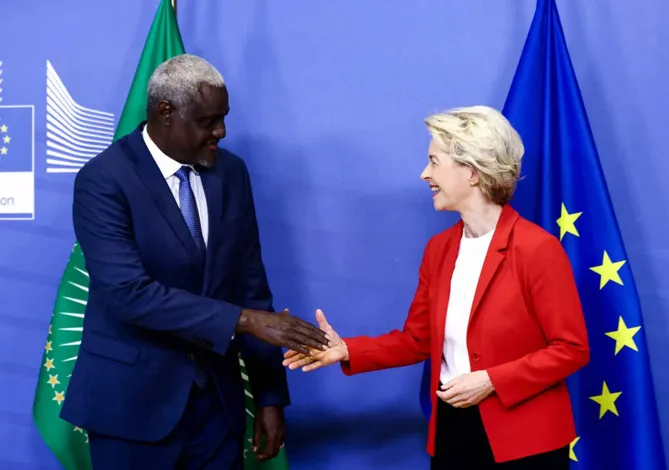
Of late, Africa has increasingly emerged as a theatre of growing geopolitical contestation, even as various external shocks—the war in Ukraine, global inflation, and the Israel-Hamas conflict—have hampered the continent’s post-COVID recovery. As a largely unexplored continent, African nations sit on troves of minerals and energy sources, many of which are critical for the green transition. Unsurprisingly, major powers like the United States (US), the European Union (EU), China, India, Japan and Australia are intensifying their collaboration with African countries and investing in exploring these resources through infrastructure and connectivity projects. As a result, infrastructure diplomacy, a key tenet in navigating global geoeconomic trends, in the continent has thrived. To that end, in 2022 and 2023, China (US$ 10 billion), the EU (US$ 164.98 billion), the US (US$ 55 billion) and Japan (US$ 30 billion) have committed vast sums of aid to enhance regional connectivity in Africa.
While China has gained the first-mover advantage over its Western adversaries through its Belt and Road Initiative (BRI), the US, EU and their Western allies have also stepped up their efforts.
While China has gained the first-mover advantage over its Western adversaries through its Belt and Road Initiative (BRI), the US, EU and their Western allies have also stepped up their efforts. In addition to the Group of Seven’s (G7) Partnership for Global Infrastructure and Investment (PGII), the EU’s latest endeavour—the Global Gateway (GG) in Africa/Europe Investment Package 2022—is another Western bid aimed at countering Chinese influence and partnering for the continent’s critical resources.
The EU’s Investment Package 2022 worth US$ 164.98 billion features 11 economic corridors, across the continent divided into three larger regional corridors—the North-Central-East African (NCEA) strategic corridor, the West African strategic corridor and the South African strategic corridor. This article looks at the NCEA corridor and analyses the geoeconomic and strategic implications of the same.
Enhancing continental connectivity through the Global Gateway
The GG investments are Europe’s bid to win over the African nations by building transport corridors which encompass airports, railways, roads and ports – critical infrastructure for bolstering national economic progress. The NCEA transnational corridor encompasses four regional corridors, across three regions. It corridor aims to build roads, railways and ports across 18 countries (see Table 1) in the central, eastern and northern African ones to impact over a dozen critical economic sectors such as transport, mining, sustainable energy, port development and blue economy sectors such as fisheries and deep-sea mining.
|
Proposed GG corridors in Africa by the EU – ODA
|
|
Corridor
|
Region
|
Potential beneficiaries
|
Major economic sectors benefiting
|
|
Libreville/Kribi/Douala-N’Djamea (816)
|
Central/East Africa
|
Gabon, Equatorial Guinea, Cameroon, Chad, São Tomé and Príncipe
|
Renewable energy development, transport infrastructure, agriculture, mining and manufacturing
|
|
Douala/Kribi-Kampala
|
Central Africa
|
Cameroon, Central African Republic, Democratic Republic of the Congo, Uganda
|
Mineral processing, critical minerals extraction, social infrastructure, renewable energy development,
|
|
Dar es Salaam-Nairobi-Addis Ababa- Berbera/Djibouti
|
East Africa
|
Tanzania, Kenya, Ethiopia, Somalia, Djibouti
|
Gold mining, mineral processing, port infrastructure, fisheries and blue economy, social infrastructure
|
|
Mombasa-Kisangani
|
East Africa
|
Kenya, Uganda, Rwanda, the Democratic Republic of the Congo
|
Gold mining, port infrastructure, shipbuilding, fisheries, deep-sea mining, sustainable mineral processing, renewable energy, railways
|
|
Cairo-Khartorum-Juba-Kampala
|
North Africa
|
Egypt, Soudan, South Sudan, Uganda
|
Mineral processing, critical minerals extraction, social infrastructure, renewable energy development
|
|
Total number of corridors: 4
|
Regions involved: 3
|
Countries involved: 18
|
Total number of sectors benefiting: 16
|
Source: Global Gateway EU/Africa Investment Dossier
Notably, eight of the above-mentioned 18 countries have huge troves of critical mineral reserves, the most in any African region. The EU hopes that like the Lobito Corridor’s MoUs, African stakeholders involved in these projects will agree to export critical minerals or the processed products thereof, to the coasts of Europe and its allies. This will bolster the EU’s energy security agenda and reinforce its geoeconomic position vis-á-vis the showdown with Russia over its invasion of Ukraine.
However, geoeconomic imperatives are not the only driving factor behind the EU investments in Africa. For long, enhancing regional connectivity and building intra-continent trade corridors have been central to instrumentalising the full potential of Africa’s Comprehensive Trade Agreement (AfCTA). Similarly, greater economic integration through building regional transport and trade corridors is a key imperative of Africa’s joint vision of 2063, adopted in 2018 by the African Union (AU). The EU’s research methodology for delineating these corridors under the GG Africa/Europe Investment package carefully amalgamated tenets of the African Vision 2063—an economic, socio-political vision adopted by the African Union in 2018, and economic imperatives of the AfCTA with its own goals and vision for EU-AU collaboration to deliver impact decisively on the grassroots level, and a wider scale.
Global Gateway vis-à-vis BRI
While the EU has presented Africa with a formidable investment initiative, its inroads in the continent face a formidable challenge from China’s BRI. Beijing’s investments in Africa are deep-rooted and dominate seven of the 16 critical economic sectors in the regions of the NCEA corridor. Chinese state and private companies have been involved for far longer in mining critical minerals, building transport infrastructure, and building and servicing energy infrastructure in Africa. For instance, China has stakes in 70 percent of DRC’s copper mines and has unrepaid borrowings from its ‘loans for minerals’ and ‘infrastructure for minerals’ deals in 11 of 18 countries participating in this corridor*. This gives Beijing leverage for exacerbating financial pressure on African governments to prioritise minerals supply to China over the EU.
The Global Gateway trumps BRI in greener initiatives. It boasts an impressive investment portfolio, detailing green infrastructure, green energy projects, critical minerals mining and the development of sustainable infrastructure alongside enhancing digital connectivity through the ‘Global Gateway Digital Connectivity and Infrastructure Initiative’.
Yet the Global Gateway trumps BRI in greener initiatives. It boasts an impressive investment portfolio, detailing green infrastructure, green energy projects, critical minerals mining and the development of sustainable infrastructure alongside enhancing digital connectivity through the ‘Global Gateway Digital Connectivity and Infrastructure Initiative’. As compared to the BRI, which has primarily focused on energy infrastructure in the continent, that to on oil, gas and coal projects, the GG’s greener projects potentially give it an edge over the BRI as the world grapples with climate mitigation challenges.
Conclusion
In the late 1990s, Western academia and policymakers had deemed Africa the ‘Lost Continent,’ as the continent grappled with militancy, economic distress, political upheaval and intra-state wars. These politico-economic issues had accentuated security risks for Western states and private companies to invest in the continent and gave leeway to China to make strategic and economic inroads therein. Today, as the world runs out of essential natural resources, the West has, but no option to enhance economic ties with African countries and turn the ‘Lost Continent’ into the ‘Land of Opportunity’.
Prithvi Gupta works as a Junior Fellow with the Strategic Studies Programme at the Observer Research Foundation
*independent analysis through author’s data compilation
The views expressed above belong to the author(s). ORF research and analyses now available on Telegram! Click here to access our curated content — blogs, longforms and interviews.




 PREV
PREV


